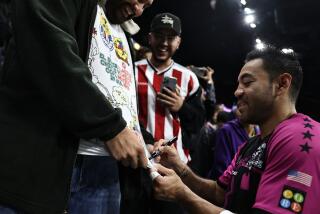In Mexico City, Cup Fever Is an Epidemic
- Share via
MEXICO CITY — For prolonged fan hysteria, there is nothing in sports like World Cup soccer.
The Super Bowl? No comparison.
The World Series? NBA championship? Stanley Cup finals? A championship fight? Not even close.
The Olympics don’t even measure up to this kind of fan fanaticism.
Millions of people are gripped in the emotion of the world’s most widespread sport, and the national fervor reaches hysteria when countries compete against each other for the world championship.
In Mexico, the 1986 World Cup is everywhere. Store windows are filled with souvenirs ranging from dolls of the mascot “Pique” to genuine World Cup footballs--it is called a football, not a soccer ball, in most countries in the world.
Streets are jammed with foreigners. There are Brazilians who samba to their destinations, and there is the slower-moving French, who appear lost away from the Champs-Elysees as they saunter down Florencia Street, Mexico’s equivalent to Paris’ famous, fashionable avenue.
On television, games are replayed around the clock. Highlights are shown at least twice a day. The morning news shows--”Hoy Mismo” is Mexico’s version of a morning talk show in the United States--spend more time reporting on the World Cup than any other sport or news story.
In three plazas in Mexico City and in other cities, gigantic television screens have been set up for people who can’t afford match tickets or don’t have TV sets to see the Mexican team’s games. Up to 5,000 people have gathered.
When Mexico plays, the craziness intensifies. Impromptu street carnivals follow each Mexican victory and combine the celebration of Mardi Gras, Carnivale and New Year’s Eve.
More than a million people flood the streets--dancing, singing, waving flags, chanting “Meh-hee-co, Meh-hee-co.” Traffic--foot and motor--come to a standstill on all the major arteries. Police barricades block off areas where throngs of revelers turn streets into promenades.
Even underground on the subways, the wildness is rampant. At the Insurgentes stop on the metro in Zona Rosa--Mexico City’s version of the French Quarter in New Orleans--dozens of youngsters crowd the platform, then storm into the subway car, refusing to allow passengers off.
They are all yelling, “Meh-hee-co, Meh-hee-co.”
Monuments become celebration points. Little children roam the streets, uncertain what’s going on but enjoying it.
The frenzied revelry of the Mexicans contrasts the tragedy and poverty that have struck the country. Last September, a devastating earthquake killed at least 9,500 people and destroyed hundreds of buildings. An economic crisis that has made a poor nation poorer is in its fourth year.
World Cup has given Mexicans something to cheer about--and they cheer relentlessly.
So do the Brazilians, the Danes, the English and the Argentinians. They, too, roam the streets of Mexico City, waving flags and shirts and other articles of clothing not usually taken off in public.
On the Saturday night before the second round began, a friendly shouting match took place on Genova Street. Patrons of the Picadilly Pub screamed themselves hoarse for their beloved England.
Across the street, barely 30 feet away in another restaurant, the yelling was for “Espana, Espana.’ ‘ And then the Spanish fans were drowned out by “Ar-hen-tin-a.”
They all were overcome by “Meh-hee-co, Meh-hee-co.”
Similar shouting contests go on virtually every night throughout the world’s largest metropolitan area.
Nothing in the United States compares to the scene. World Series or Super Bowl celebrations have been wild, but those festivities last a few days, not weeks.
When the U.S. hockey team won the gold medal at Lake Placid, it produced a national euphoria. But there was none of the prolonged street parties of the World Cup. Not even a Superdome filled with pom-pom waving fans equals the electric feeling and constant roar of more than 100,000 people cheering their country.
When Denmark, playing in its first World Cup, beat West Germany, the partying in Copenhagen went on through the night. And that was only the first round.
It’s only soccer, an American fan might say. But everywhere else, it’s an international obsession.
More to Read
Sign up for Essential California
The most important California stories and recommendations in your inbox every morning.
You may occasionally receive promotional content from the Los Angeles Times.













